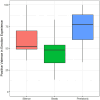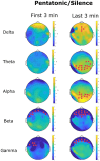Pentatonic sequences and monaural beats to facilitate relaxation: an EEG study
- PMID: 38686091
- PMCID: PMC11056517
- DOI: 10.3389/fpsyg.2024.1369485
Pentatonic sequences and monaural beats to facilitate relaxation: an EEG study
Abstract
Introduction: In two studies we investigated if specific acoustic stimulations could be more effective to induce a relaxation response in comparison to silence. Acoustic stimulations included monaural beats and musical sequences based on a pentatonic scale.
Methods: In the first study, 47 participants evaluated monaural beats and pentatonic sequences presented through loudspeakers and varying along three frequencies (0.2, 2, 4 Hz). In the second study, 31 participants relaxed with their eyes closed for 10 min during a passive listening of monaural beats and a pentatonic sequence presented through loudspeakers. A silence condition was introduced as control. All auditory stimuli were designed with a temporal modulation of 0.2 Hz. Concomitant EEG was recorded with a 64-channel system and spectral analysis was performed on delta, theta, alpha, beta, and gamma oscillations to test if each of the three auditory stimulations had a significant effect on EEG spectral power in comparison to silence.
Results: In the first study, pentatonic sequences were evaluated as more pleasant and more relaxing than monaural beats. Pleasantness and relaxation were inversely related to frequency. Visual imagery and emotion induction had higher frequency and were rated with a more positive valence in pentatonic sequences than in monaural beats. In the second study monaural beats in comparison to silence strongly decreased beta and gamma oscillations in the first three minutes and strongly increased theta oscillations in the last three minutes. Pentatonic sequences increased delta, theta, and alpha oscillations in the last three minutes while decreasing beta, and gamma oscillations for the whole auditory stimulation.
Discussion: The results show that auditory signals with a very low temporal modulation (0.2 Hz) could be more effective than silence in inducing a relaxation response. Although 0.2 Hz monaural beats were effective in inducing a relaxation response, they tended to be perceived as unpleasant. Pentatonic sequences could be considered as a better alternative to promote relaxation by auditory stimulation.
Keywords: EEG; beats; pentatonic sequences; relaxation; silence.
Copyright © 2024 Costa, Visentin, Occhionero, Tonetti, Prodi and Natale.
Conflict of interest statement
The pentatonic sequence design and acoustical implementation is subject to patent pending # 102023000007413 “Device to facilitate sleep onset” presented by IOF (www.hi-interiors.com). The authors declare that the research was conducted in the absence of any commercial or financial relationships that could be construed as a potential conflict of interest.
Figures











Similar articles
-
Intracranial electroencephalography power and phase synchronization changes during monaural and binaural beat stimulation.Eur J Neurosci. 2015 Jan;41(2):254-63. doi: 10.1111/ejn.12760. Epub 2014 Oct 25. Eur J Neurosci. 2015. PMID: 25345689
-
Modulation of Mind Wandering Using Monaural Beat Stimulation in Subjects With High Trait-Level Mind Wandering.Front Psychol. 2022 Jun 13;13:815442. doi: 10.3389/fpsyg.2022.815442. eCollection 2022. Front Psychol. 2022. PMID: 35769725 Free PMC article.
-
Effects of binaural and monaural beat stimulation on attention and EEG.Exp Brain Res. 2021 Sep;239(9):2781-2791. doi: 10.1007/s00221-021-06155-z. Epub 2021 Jul 10. Exp Brain Res. 2021. PMID: 34245340 Free PMC article.
-
Comparative evaluation of anxiety level during restorative treatment using no music, monaural beats, and binaural auditory beats as audio distraction behavior guidance technique in children aged 6-12 years: A randomized clinical trial.J Indian Soc Pedod Prev Dent. 2023 Apr-Jun;41(2):156-162. doi: 10.4103/jisppd.jisppd_104_23. J Indian Soc Pedod Prev Dent. 2023. PMID: 37635475 Clinical Trial.
-
The Impact of Monaural Beat Stimulation on Anxiety and Cognition.Front Hum Neurosci. 2017 May 15;11:251. doi: 10.3389/fnhum.2017.00251. eCollection 2017. Front Hum Neurosci. 2017. PMID: 28555100 Free PMC article.
References
-
- Bartlett D. L. (1996). “Physiological responses to music and sound stimuli” in Handbook of music psychology. ed. Hodges D. A. (San Antonio: IMR Press; ), 343–385.
-
- Benson H., Arns P. A., Hoffman J. W. (1981). The relaxation response and hypnosis. Int. J. Clin. Exp. Hypn. 29, 259–270. doi: 10.1080/00207148108409160 - DOI
LinkOut - more resources
Full Text Sources

